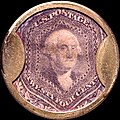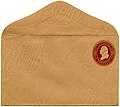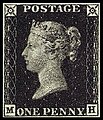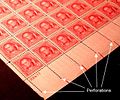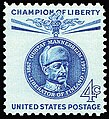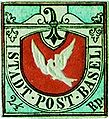Portal:Philately
| Philately portal | WikiProject Philately |
The Philately Portal
Philately is the study of revenue or postage stamps. This includes the design, production, and uses of stamps after they are issued. A postage stamp is evidence of pre-paying a fee for postal services. Postal history is the study of postal systems of the past. It includes the study of rates charged, routes followed, and special handling of letters.
Stamp collecting is the collecting of postage stamps and related objects, such as covers (envelopes, postcards or parcels with stamps affixed). It is one of the world's most popular hobbies, with estimates of the number of collectors ranging up to 20 million in the United States alone.

The Pony Express was an American express mail service that used relays of horse-mounted riders between Missouri and California. It was operated by the Central Overland California and Pikes Peak Express Company.
During its 18 months of operation, the Pony Express reduced the time for messages to travel between the east and west US coast to about 10 days. It became the west's most direct means of east–west communication before the first transcontinental telegraph was established (October 24, 1861), and was vital for tying the new U.S. state of California with the rest of the United States. (Full article...)Selected article -

Postage stamps of Pakistan are those issued since Pakistan's independence in 1947. Pakistan Post has issued more than 600 sets and singles totalling more than 1300 stamps. Immediately after the independence of Pakistan in 1947, the new Pakistan government was preoccupied with setting up the government so British Indian stamps continued in use without an overprint as was the practice in other countries.
The history of postage stamps in the region dates back to 1852, when Sir Bartle Frere of the British East India Company became the Chief Commissioner of Sind in 1851 and in 1852. Following the British example set by Rowland Hill, Frere improved upon the operations of the postal system of Sindh, introduced a cheap and uniform rate for postage (independent of distance travelled) and initiated the production of the Scinde Dawk stamps. These became the forerunners of the adhesive stamps to be used throughout India, Burma, the Straits Settlements and other areas controlled by the British East India Company. Their usage ceased with the introduction of official British Indian stamps in 1854. (Full article...)Selected images
Did you know (auto-generated)

- ... that Iranian-American aerospace engineer Joe Youssefi was posthumously awarded a gold medal for his collection of Persian stamps?
- ... that a new Christmas stamp that debuted in the 350-person town of Bethlehem, Georgia, in 1967 got so much attention that the two-employee post office had to hire forty-three temporary workers?
- ... that James Diossa rescued the only public library and post office in Central Falls, Rhode Island, when the city went into bankruptcy?
- ... that Amrita Sher-Gil's painting Hill Women appeared on a 1978 Indian postage stamp?
- ... that Argentinian Ricardo D. Eliçabe qualified as a physician, co-founded a petroleum refinery, and wrote about forgeries of Bolivia's first stamps?
- ... that British philatelist Alma Lee specialised in the "standing Helvetia" stamps of Switzerland?
General images -
Selected stamp -
The Whole Country is Red is a Chinese postage stamp, issued on 24 November 1968, which contained a problem with the design. The stamp features a map of China with the words "The Whole Country is Red" (Chinese: 全国山河一片红), with a worker, farmer, and soldier standing below with copies of Quotations from Chairman Mao, but Taiwan is not shaded red. The face value of the stamp is 8 fen.
Taiwan was not shaded red as at the time of printing, it was (and remains so ) under the control of the Republic of China instead of the PRC. The official reason given for the withdrawal of the stamp was that the Spratly and Paracel Islands were missing from the map, as well as the borders with Mongolia, Bhutan, and Myanmar being incorrectly drawn. The stamp had been distributed for less than half a day when an editor at China Cartographic Publishing House noticed the problem with Taiwan and reported it to the Ministry of Posts and Telecommunications. As a result, all Chinese post offices had to stop selling the stamp and return all copies, with only a small quantity making it to private collectors. The designer of the stamp, Wang Weisheng, said in an AFP interview, "For a long time I was really worried that I would be jailed". (Full article...)List articles

- List of philatelists
- List of most expensive philatelic items
- List of postage stamps
- Lists of people on postage stamps (article) • (Category page)
- List of entities that have issued postage stamps (A–E)
- List of entities that have issued postage stamps (F–L)
- List of entities that have issued postage stamps (M–Z)
- List of postal services abroad
- Timeline of postal history
Related portals
Topics
Categories
WikiProject
![]() WikiProject Philately organizes the development of articles relating to philately. For those who want to skip ahead to the smaller articles, the WikiProject also maintains a list of articles in need of improvement or that need to be started. There are also many red inked topics that need to be started on the list of philatelic topics page.
WikiProject Philately organizes the development of articles relating to philately. For those who want to skip ahead to the smaller articles, the WikiProject also maintains a list of articles in need of improvement or that need to be started. There are also many red inked topics that need to be started on the list of philatelic topics page.
Selected works
- Williams, Louis N., & Williams, Maurice (1990). Fundamentals of Philately {revised ed.). American Philatelic Society. ISBN 0-9335-8013-4.
{{cite book}}: CS1 maint: multiple names: authors list (link) - Hornung, Otto (1970). The Illustrated Encyclopedia of Stamp Collecting. Hamlyn. ISBN 0-600-01797-4.
- Stuart Rossiter & John Fowler (1991). World History Stamp Atlas (reprint ed.). pub: Black Cat. ISBN 0-7481-0309-0.
Wikimedia
The following Wikimedia Foundation sister projects provide more on this subject:
-
Commons
Free media repository -
Wikibooks
Free textbooks and manuals -
Wikidata
Free knowledge base -
Wikinews
Free-content news -
Wikiquote
Collection of quotations -
Wikisource
Free-content library -
Wikiversity
Free learning tools
Other Portals
Sources
- ^ "Philatelic Collections: General Collections". British Library. 2003-11-30. Archived from the original on 30 June 2011. Retrieved 2011-01-16.




![Image 2Unissued 1956 £1 Jamaican chocolate and violet, the first stamp designed for Queen Elizabeth II. Held in the British Library Crown Agents Collection.[1]](http://upload.wikimedia.org/wikipedia/commons/thumb/9/9b/Stamp_Jamaica_1956_unissued_1sh.jpg/120px-Stamp_Jamaica_1956_unissued_1sh.jpg)




